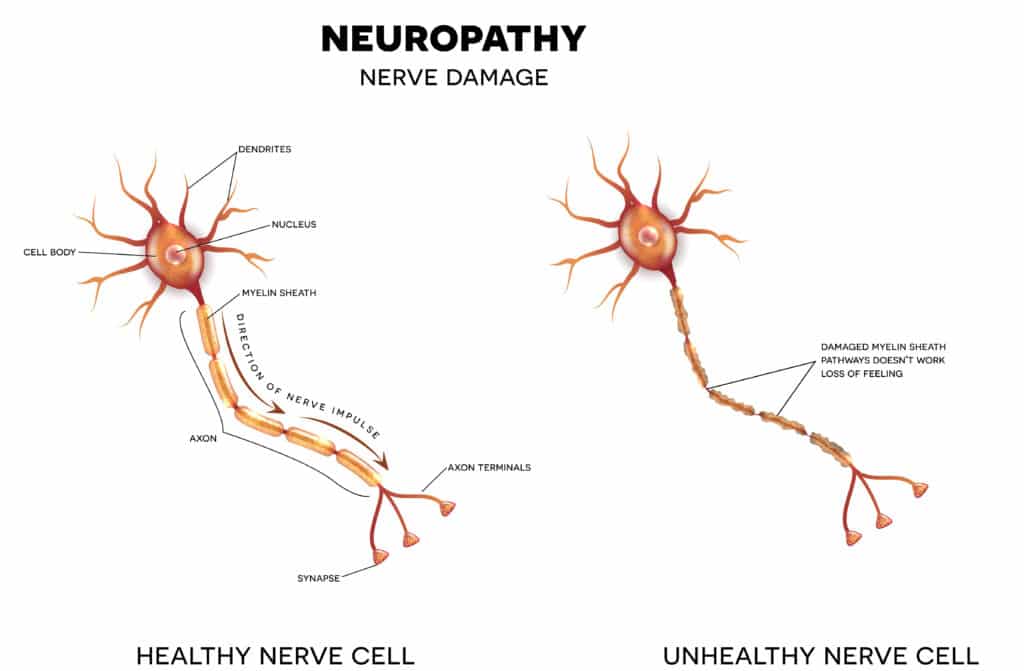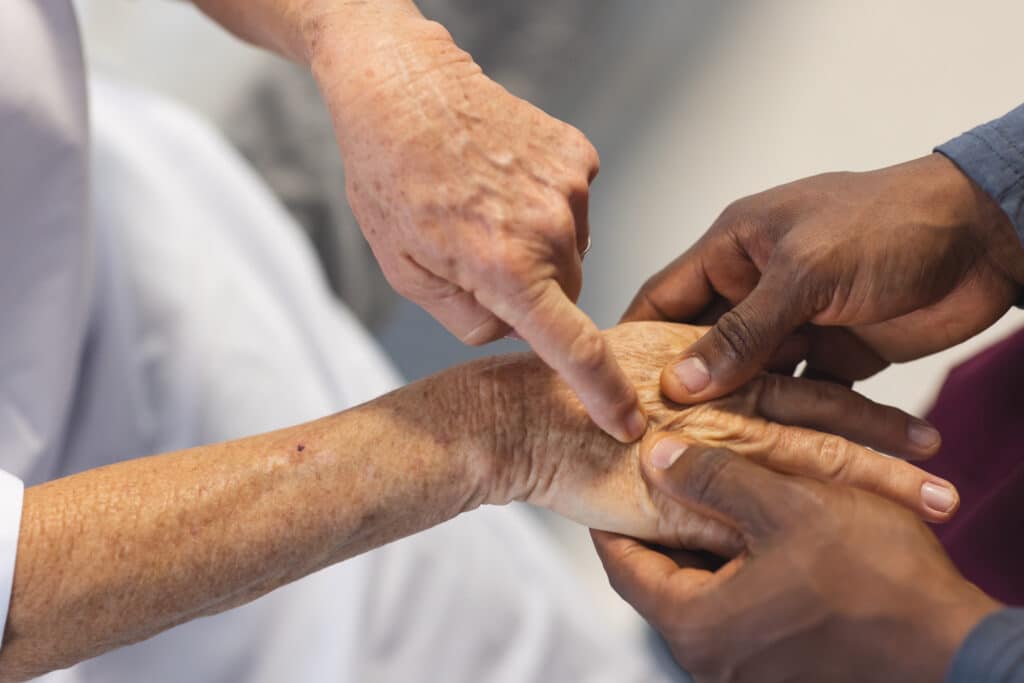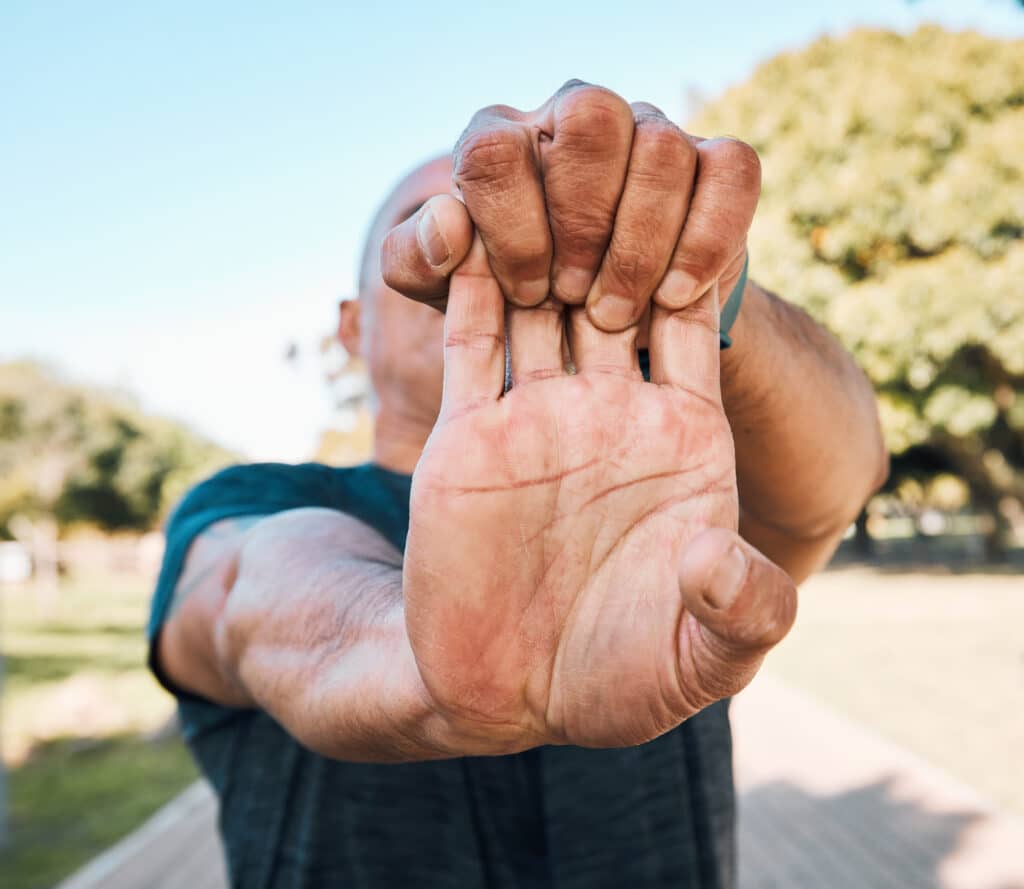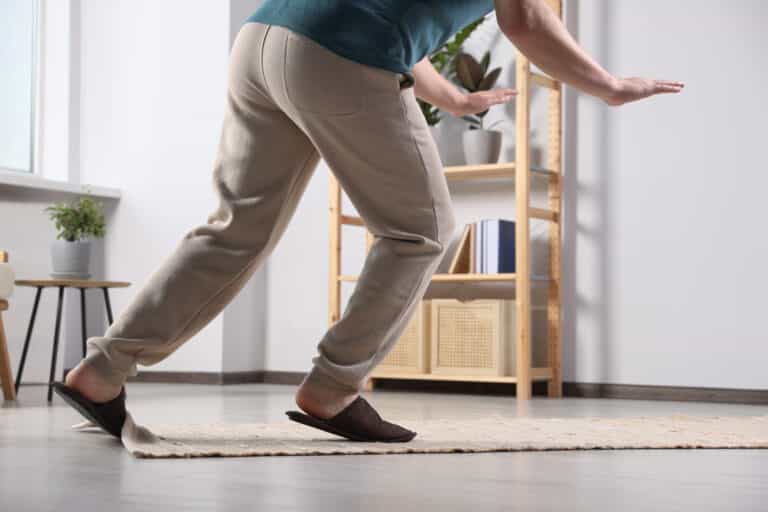Do your hands often tingle with that frustrating “pins and needles” sensation? Are everyday activities such as buttoning a shirt or holding a pen increasingly challenging? You’re not alone.
Hand neuropathy can affect anyone; as we age, it can become an even more common concern. But you don’t have to let hand neuropathy hold you back!
In this post, we’ll explore hand neuropathy exercises designed especially for older adults who want to regain control of their hand function and alleviate discomfort.
Causes and Symptoms of Hand Neuropathy
Understanding what leads to hand neuropathy is like piecing together a puzzle. It’s not just about one cause; it’s a mix of several factors that can affect the nerves in your hands, making everyday tasks challenging. Whether it’s from conditions like diabetes, repetitive strain injuries, or even certain medications, the origins of hand neuropathy are as diverse as its symptoms.

A Closer Look at the Causes
- Diabetes: Often a leading actor in this scenario, diabetes can damage the peripheral nerves due to high blood sugar levels, making it a common culprit behind hand neuropathy.
- Carpal Tunnel Syndrome: Not just a buzzword for office workers, carpal tunnel syndrome compresses the nerve running through your wrist, often leading to neuropathy symptoms in the hand.
- Injuries: From fractures to cuts, any injury that directly impacts the nerves in your hand can lead to neuropathy. It’s like cutting a cable line – the connection gets lost.
- Vitamin Deficiencies: Vitamins B12 and E are crucial for nerve health. Lacking these can disrupt nerve function, leading to neuropathy.
- Autoimmune Diseases: Conditions where the body mistakenly attacks its tissues, like rheumatoid arthritis, can also affect the nerves in the hands.
Symptoms to Watch For
The experience of hand neuropathy can vary widely, but there are some common threads that many people share.
- Tingling and Numbness: Imagine that “pins and needles” feeling when your hand falls asleep, but it doesn’t wake up. That’s a hallmark of neuropathy.
- Weakness: When your grip doesn’t feel as strong as it used to be, or picking up small objects becomes a Herculean task, neuropathy might be at play.
- Pain: This isn’t just any pain. It’s often described as a burning or electric shock-like sensation that can be distressing.
- Sensitivity to Touch: When even the lightest touch feels uncomfortable or painful, it’s a sign that the nerves in your hand are overreacting due to neuropathy.
By recognizing these symptoms early and understanding their potential causes, you’re taking a crucial step toward managing hand neuropathy. With the right approach, including targeted exercises and professional guidance, regaining comfort and function in your hands is within reach.
The Benefits of Exercise for Hand Neuropathy

Exercise plays a crucial role in improving blood circulation and nerve function. Research has shown that regular physical activity can enhance the blood flow to the affected areas, providing essential nutrients and oxygen to the nerves.2
Exercise can contribute to the relief of symptoms associated with hand neuropathy. I have seen the most improvement in my patients with neuropathy in those who regularly exercise.
Understanding how these exercises work to alleviate symptoms is crucial for their effectiveness.
Improved Blood Circulation
Exercise, particularly cardiovascular exercise, promotes better blood circulation throughout the body, including the hands.
This increased blood flow delivers essential nutrients and oxygen to the hand’s nerves, aiding their repair and regeneration. Better circulation also helps remove waste products and toxins from the nerve cells.
Nerve Function Enhancement
Hand neuropathy often involves damage to the peripheral nerves, which transmit sensory information from the hands to the brain. Exercise can stimulate these nerves and encourage them to function more effectively.
By using specific hand exercises, individuals can improve nerve conduction and signal transmission, reducing symptoms like tingling and numbness.
Reduced Inflammation
Inflammation can exacerbate the symptoms of hand neuropathy. Exercise can help regulate the body’s inflammatory responses, mitigating the pain and discomfort experienced in the hands.
Muscle Strength and Coordination
Some hand exercises strengthen the hand and wrist muscles. Stronger muscles can provide better support for the nerves, reducing the risk of nerve compression. Improved coordination and muscle control can also make it easier to perform everyday tasks.
Research has demonstrated the positive impact of exercise on peripheral neuropathy, including hand neuropathy. This scientific evidence highlights the role of exercise in enhancing nerve function and reducing symptoms.2,3
Incorporating these exercises into your routine can be an effective and non-invasive way to manage hand neuropathy.
Still, consulting a healthcare professional for guidance tailored to your specific condition is essential. The science behind these exercises is encouraging, offering hope and practical solutions for those dealing with hand neuropathy.
Hand Neuropathy Pain Management

One of the most persistent and distressing aspects of hand neuropathy is the pain it inflicts. This discomfort can significantly affect an individual’s quality of life, challenging even the simplest of tasks. Fortunately, exercise is a powerful ally in the battle against this pain.
When you engage in physical activity, several mechanisms come into play to help alleviate the pain associated with hand neuropathy. The first and foremost is the improvement in blood circulation.
Exercise enhances blood flow, carrying vital nutrients and oxygen to the affected nerves. Increased nourishment contributes to repairing and recovering these damaged nerves, ultimately reducing pain and discomfort.
Another remarkable aspect of exercise is the release of endorphins, the body’s natural painkillers. Endorphins not only provide a sense of euphoria but also act as effective pain relievers.
They can significantly lessen the intensity of pain experienced by individuals with hand neuropathy, allowing for improved comfort and a more positive outlook.
Hand Neuropathy Management for Improved Function
Hand function is an integral part of our daily lives, and when hand neuropathy begins to compromise this function, it can be profoundly distressing.
My patients typically mention their hands’ limited mobility and strength, making even the simplest tasks arduous. From buttoning a shirt to using cutlery, their loss of dexterity and strength can significantly impact their independence and overall well-being.
The good news is that targeted exercises can help you regain and enhance hand function. These exercises focus on various aspects, including improving hand flexibility, strength, and sensory perception.
By incorporating them into your daily routine, you can begin the journey toward reclaiming control over your hands and, consequently, your life.
Hand Neuropathy Exercises

Now, let’s transition to the practical aspect of this journey, where we explore the types of hand neuropathy exercises that you can integrate into your daily routine. These exercises address specific aspects of hand function and offer a comprehensive approach to managing the condition.
Range of Motion Exercises
Finger Spread Stretching
Gently stretching your fingers by spreading them apart and bringing them back together can enhance flexibility. Hold each stretch for a few seconds, aiming to gradually increase your range of motion.
Wrist Extensor Stretch
These exercises target the muscles and tendons in your forearm, promoting wrist flexibility. Extend your arm, palm up, and use your other hand to bend your wrist forward and backward gently. These stretches can ease the stiffness often experienced by individuals with hand neuropathy.
Thumb Touch
This exercise is invaluable for improving finger dexterity. Touch your thumb to the tip of each finger, one at a time. The repetitive nature of this exercise enhances coordination and precision.
Strength-Building Exercises
Grip Strengthening
A strong grip is essential for various daily activities. Squeeze a soft stress ball or a foam pad for a few seconds, then release. Consistency and repetition with this exercise can significantly improve your hand’s strength and endurance.
In the video above, Kathy uses a small towel to demonstrate a great grip-strengthening technique.
Finger Pinch
This exercise focuses on pinch strength, vital for grasping or holding small objects. Place a soft ball or a sponge between your fingers and thumb, then squeeze it. Regular practice can lead to a noticeable improvement in pinch strength.
Wrist Flexor and Extensor Strengthening
Strengthening the muscles in your forearm is crucial for holistic hand strength. Perform wrist flexion and extension exercises using a lightweight dumbbell or a resistance band. These exercises not only improve wrist strength but also support overall hand function.
Sensory Stimulation Exercises
- Texture Exploration: Exploring various textures like sandpaper, silk, or rough fabric can be a fascinating and effective way to stimulate sensory perception in your hands. Regularly exposing your hands to different textures can help reawaken your sense of touch.
- Temperature Sensation: Another intriguing exercise involves using warm and cold water baths to stimulate your hand’s temperature sensation. By alternating between warm and cold water, you can enhance the sensitivity of your hands and fingers.
Note: it’s a good idea to test the water temperature with a part of your body that is not experiencing neuropathy or to use a thermometer to avoid burns.
These exercises offer a holistic approach to improving hand function in individuals with hand neuropathy. Regular practice, patience, and gradual progression can yield significant results, empowering you to regain control over your daily activities and experience greater independence.
Getting the Most Out of Your Hand Neuropathy Exercises
While some of these exercises might seem simple, it’s also important to be careful while performing them. Since hand neuropathy causes limited sensation, it may be easier to injure yourself than it might seem.
Here are some basic guidelines for getting the most out of your hand neuropathy exercise practice safely.
Proper Technique
Using the correct technique for hand exercises is essential to your success and safety. When performing exercises, follow the instructions carefully, paying attention to proper form and movement.
Incorrect technique can lead to injury or exacerbate hand neuropathy symptoms. For example, if you don’t execute grip-strengthening exercises correctly, you may strain your hand muscles and worsen your condition.
What about if you’re feeling unsure or experiencing pain with exercise? In that case, seeking guidance from a healthcare professional or a physical therapist who can teach you the correct techniques and monitor your progress is a good idea.
Proper technique also maximizes the effectiveness of your exercises. You want to target the right muscles and stimulate nerve function most effectively. Maintaining good form will ensure that you’re exercising both beneficially and safely.
Gradual Progression
When you’re eager to alleviate hand neuropathy symptoms, wanting to see rapid improvement is understandable. However, resisting the temptation to rush your exercise routine is vital. Gradual progression is critical to a safe, sustainable journey toward improved hand function.
Overexerting your hands or increasing exercise intensity too rapidly can lead to unnecessary strain or injury. Instead, focus on incremental progress.
Start with exercises that match your current abilities and gradually increase the intensity as your hand strengthens. This incremental approach minimizes the risk of injury and allows your body to adapt to the new demands you’re placing on it.
Patience is a valuable virtue in your journey to hand wellness. Remember that each small step toward improvement is a significant victory.
Celebrate your progress, no matter how gradual, and trust the process. With time and consistent effort, you’ll be amazed at the positive changes you can achieve in managing your hand neuropathy.
Talking to Your Doctor About Hand Neuropathy
Starting any exercise regimen, mainly when dealing with a medical condition like hand neuropathy, should always begin with a conversation with a healthcare professional. They are pivotal in providing tailored guidance and ensuring safety throughout the process.
Hand neuropathy can be caused by various underlying medical conditions, including diabetes, carpal tunnel syndrome, or even side effects of certain medications.
Consulting a healthcare professional is essential to assess your specific situation. They can help you understand the root cause of your hand neuropathy, its severity, and any potential contraindications that may impact your exercise plan.
Additionally, they can recommend exercises that are most suitable for your condition. What works for one individual may not be appropriate for another, so personalized guidance is invaluable.
Consulting a healthcare professional ensures you confidently embark on your exercise journey, knowing you’re taking the proper steps for your unique circumstances.
Summary
Navigating through the challenges of hand neuropathy requires a blend of knowledge, proactive management, and patience. Individuals can take timely action by understanding its varied causes and recognizing the early signs of tingling, numbness, and weakness. Incorporating targeted exercises, following professional guidance, and a gradual approach to physical activity can make a substantial difference in alleviating symptoms and enhancing quality of life.
This article sheds light on the importance of exercise in managing hand neuropathy and emphasizes the value of consulting with healthcare professionals to tailor a safe and effective regimen. Remember, the journey to regaining hand function and comfort is a marathon, not a sprint, marked by small victories and steady progress.
Key Takeaways
- Hand neuropathy has a range of causes, from diabetes and carpal tunnel syndrome to injury, each impacting nerve health differently.
- Symptoms vary widely but commonly include tingling, numbness, and muscle weakness, affecting daily activities.
- Exercise is beneficial, improves blood circulation and nerve function, and alleviates symptoms.
- Consulting healthcare professionals is crucial for personalized advice and to ensure exercises are done safely and effectively.
- Proper technique and gradual exercise progression are key to preventing injury and maximizing benefits.
- Patience and consistency with exercise routines can lead to significant improvements in managing hand neuropathy symptoms.
References
- Khdour, M. R. (2020). Treatment of diabetic peripheral neuropathy: a review. Journal of Pharmacy and Pharmacology, 72(7), 863-872.
- Kluding, P. M., Pasnoor, M., Singh, R., Jernigan, S., Farmer, K., Rucker, J., … & Wright, D. E. (2012). The effect of exercise on neuropathic symptoms, nerve function, and cutaneous innervation in people with diabetic peripheral neuropathy. Journal of Diabetes and its Complications, 26(5), 424-429.
- Maugeri, G., D’Agata, V., Trovato, B., Roggio, F., Castorina, A., Vecchio, M., … & Musumeci, G. (2021). The role of exercise on peripheral nerve regeneration: from animal model to clinical application. Heliyon, 7(11).






